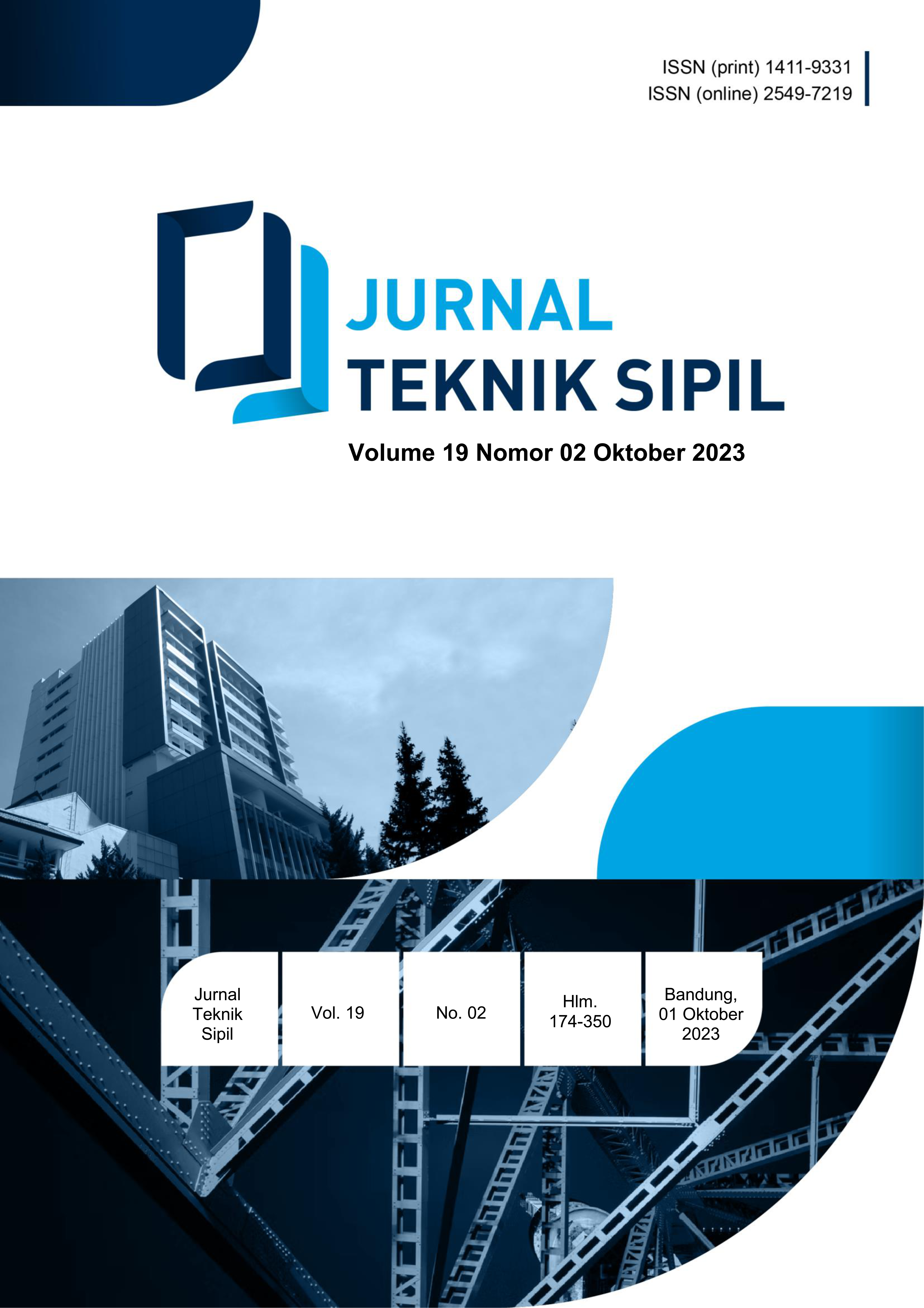Mechanical Behavior of Poorly Graded Sandy Soil Using Compaction and Direct Shear Tests
DOI:
https://doi.org/10.28932/jts.v19i2.6042Keywords:
Shear Strength, Mechanical Properties, Poor Sand, CompactionAbstract
Soil has important elements for living things as a place to live, building materials and planting media. The diversity of soil properties has been understood in various fields of science. Soil resistance greatly affects the stability and carrying capacity of the soil in civil buildings. Soil samples were taken from Sidorejo Village, Nganjuk Regency, which are classified as poorly graded sandy soils (SP). Many investigations have been made regarding the physical and mechanical properties of soil by examining compaction and shear strength. However, there are still many researchers who do not know the soil mechanical behavior in detail regarding soil (SP). The compaction test was carried out using the Standard Proctor Test method with the addition of 2.5% water to each sample, followed by a shear strength test using the Direct Shear Test method from compaction samples with maximum wet weight. This study aims to determine the mechanical behavior of poorly graded sand (SP) on shear strength. The shear strength test obtained a cohesion value of 2.0305 kPa and a shear angle of 28.892°. Based on the research results, soil mechanical properties (SP) can be used as a reference for construction on the same soil type and soil classification.Downloads
References
Al-Badran, Y. M., & Al-Ameri, A. F. (2020). Effect of Adding Sand on Clayey Soil Shear Strength. IOP Conference Series: Materials Science and Engineering, 870(1). https://doi.org/10.1088/1757-899X/870/1/012079
ASTM 698-07. (2007). ASTM 698-07: Standard Test Methods for Laboratory Compaction Characteristics of Soil Using Standard Effort (12 400 ft-lbf/ft3 (600 kN-m/m3)). ASTM International, 3, 15.
ASTM C136. (2019). ASTM C136/C136M Standard Test Method for Sieve Analysis of Fine and Coarse Aggregates. ASTM Standard Book, 3–7.
ASTM D3080. (2003). ASTM D 3080 - 03 Direct Shear Test of Soilds Under Consolidated Drained Conditions. ASTM International, 04, 7.
Cao, G., Wang, W., Yin, G., & Wei, Z. (2019). Experimental Study of Shear Wave Velocity in Unsaturated Tailings Soil with Variant Grain Size Distribution. Construction and Building Materials, 228, 116744. https://doi.org/10.1016/j.conbuildmat.2019.116744
Das. (2013). Principles of Geotechnical Engineering. Journal of Chemical Information and Modeling, 53(9), 1689–1699.
Deb, K., Sawant, V. A., & Kiran, A. S. (2010). Effects of Fines on Compaction Characteristics of Poorly Graded Sands. International Journal of Geotechnical Engineering, 4(2), 299–304. https://doi.org/10.3328/IJGE.2010.04.02.299-304
Malizia, J. P., & Shakoor, A. (2018). PT US CR. Engineering Geology, #pagerange#. https://doi.org/10.1016/j.enggeo.2018.07.028
Nugraha, A. S. (2020). Pengaruh Energi Pemadatan di Laboratorium Terhadap Parameter Kompaksi Material Crushed Limestone Padalarang. Jurnal Teknik Sipil, 16(1), 118–132. https://doi.org/10.28932/jts.v16i1.2496
Rehman, Z. ur, Khalid, U., Farooq, K., & Mujtaba, H. (2018). On Yield Stress of Compacted Clays. International Journal of Geo-Engineering, 9(1). https://doi.org/10.1186/s40703-018-0090-2
Rishavilenda, D. S., & Desiani, A. (2018). Menggunakan Geotextile Woven dan Non Woven. Jurnal Teknik Sipil, 14(c), 105–200.
Su, L. J., Zhou, W. H., Chen, W. Bin, & Jie, X. (2018). Effects of Relative Roughness and Mean Particle Size on the Shear Strength of Sand-Steel Interface. Measurement: Journal of the International Measurement Confederation, 122, 339–346. https://doi.org/10.1016/j.measurement.2018.03.003
Vallejo, L. E. (2001). Interpretation of the Limits in Shear Strength in Binary Granular Mixtures. Canadian Geotechnical Journal, 38(5), 1097–1104. https://doi.org/10.1139/cgj-38-5-1097
Wang, C., Li, S. yang, He, X. jia, Chen, Q., Zhang, H., & Liu, X. yu. (2021). Improved Prediction of Water Retention Characteristic Based on Soil Gradation and Clay Fraction. Geoderma, 404(October 2020), 115293. https://doi.org/10.1016/j.geoderma.2021.115293
Wang, H.L., Zhou, W.-H., Yin, Z.-Y., & Jie, X.-X. (2019). Effect of Grain Size Distribution of Sandy Soil on Shearing Behaviors at Soil–Structure Interface. Journal of Materials in Civil Engineering, 31(10), 1–10. https://doi.org/10.1061/(asce)mt.1943-5533.0002880
Wang, T., Liu, S., Feng, Y., & Yu, J. (2018). Compaction Characteristics and Minimum Void Ratio Prediction Model for Gap-Graded Soil-Rock Mixture. Applied Sciences (Switzerland), 8(12). https://doi.org/10.3390/APP8122584
Yuan, G., Zhang, J., Ren, Z., & Song, Z. (2022). Research on Mechanical Performance and Micro-Structural Characteristics for Large Graded Aggregates. Construction and Building Materials, 341 (May), 127860 . https://doi.org/10.1016/j.conbuildmat.2022.127860
Zhou, W. H., Jing, X. Y., Yin, Z. Y., & Geng, X. (2019). Effects of Particle Sphericity and Initial Fabric on The Shearing Behavior of Soil–Rough Structural Interface. Acta Geotechnica, 14(6), 1699–1716. https://doi.org/10.1007/s11440-019-00781-2
Downloads
Published
How to Cite
Issue
Section
License
Copyright (c) 2023 Arif Rivianto, Agata Iwan Candra, Mahardi Kamalika Khusna Ali, Gilang Wahyu Kottama, Mokhamat Wildan Prasetyo, Muhamad Rizal Agus Joko Budiawan, Muhammad Rifqi Fatkhur Rohman, Muhammad Sousa Taufani

This work is licensed under a Creative Commons Attribution-NonCommercial 4.0 International License.















